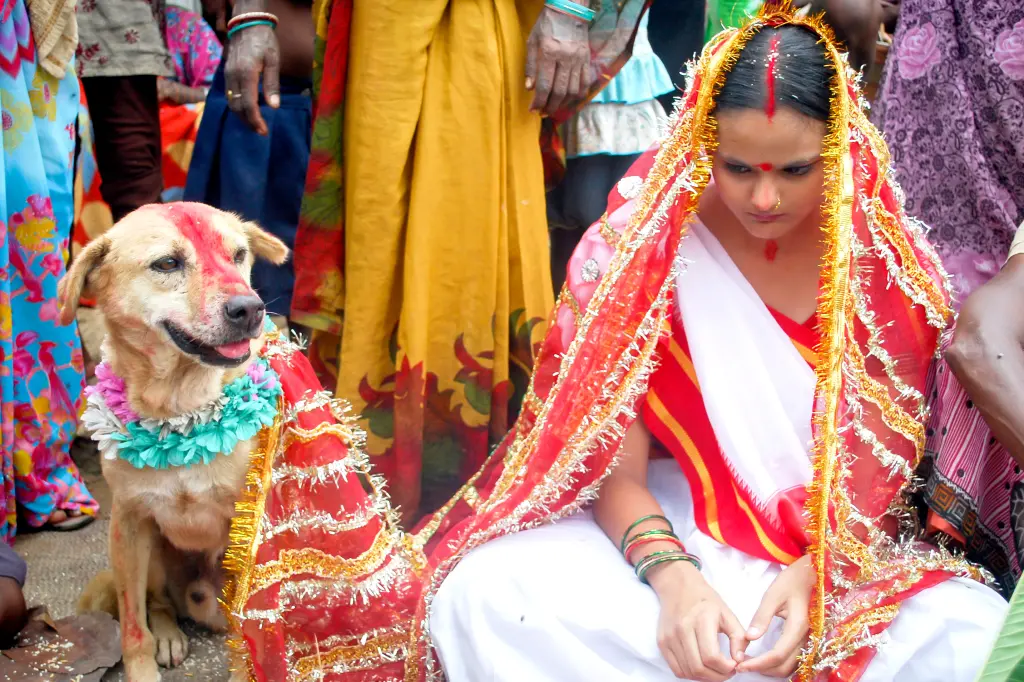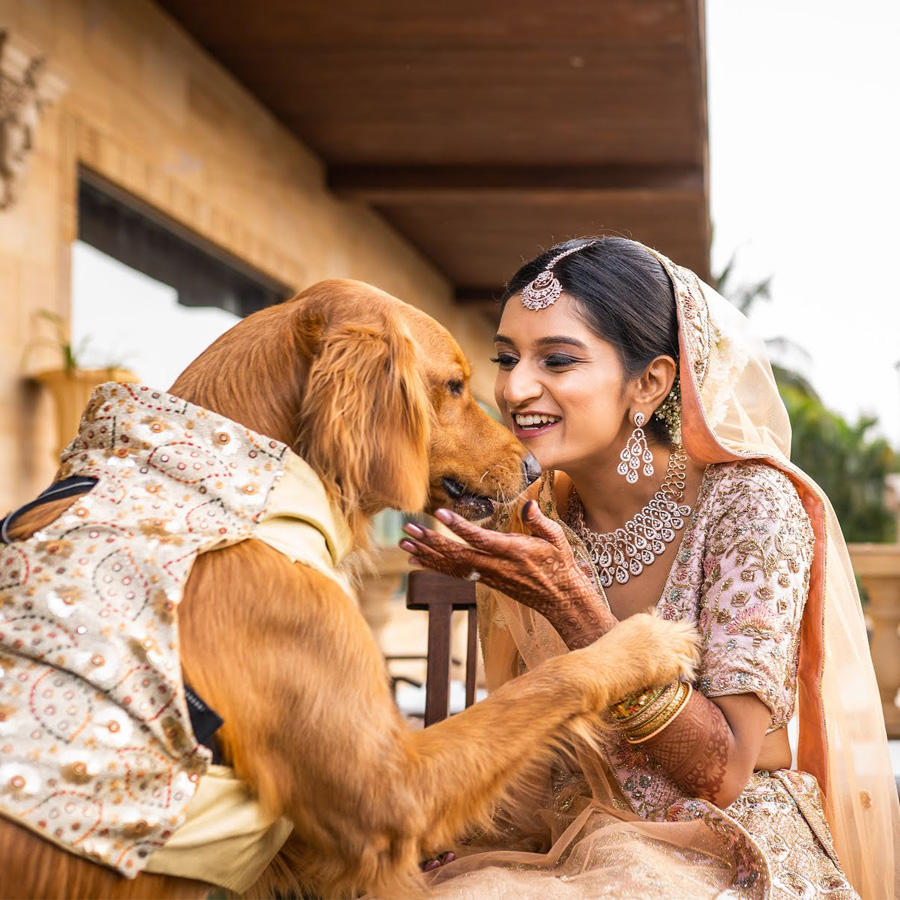Picture Pets at an Indian Traditional Wedding


A wedding is one of the most valued and elaborately planned functions in everybody’s life, and in India, where culture, tradition, and family values are so deeply enrooted, the function assumes a more grandiose form. Capturing a traditional Indian wedding requires stunning rituals and vibrant decoration with intricate attire and tender moments, calling for meticulous planning and technical skills—not to mention a feel for the culture. But what happens when there is a furry companion?
More and more people involve their pets in the wedding celebration, so capturing that could personalize your portfolio as a photographer.
In this essay, we dwell on how someone could go ahead and photograph animals during traditional marriages among Indians but still be sensitive to the various hindrances and also the cultural standpoint that such an occasion may mean or suggest.
Before getting into the technicalities of photographing the pets, it is important to understand the role they play in traditional Indian weddings. While they may not be part of the very core of the ceremony, pets do form part of the celebration.

For instance, dogs may at times be fantastically attired or dressed up and incorporated into major ritualistic moments, such as the groom’s procession, in which they might be dressed up to do some kind of symbolic act, such as guarding the bride or escorting the groom down the aisle.
With the growing trend of pet parenting, pets have turned into family, and that can be well reflected in the weddings themselves. Be it the time of being included in the pre-wedding photoshoot to posing during family portraits, these pets become a part of those moments in creating lifelong memories, and as a photographer, that is something you should take care of.
The bottom line is that while photographing pets, especially at an important event like an Indian wedding, preparation is the key.
Discuss with the couple their requirements as far as their pets are concerned in regard to the wedding. Do they want the pets to participate in any rituals or even just be a part of pre-wedding photos, perhaps even joining the baraat? Understand the nature of the pet—some are quite cool and composed while others get agitated or excited with big crowds.
Knowing this in advance will help you anticipate the challenge and be better prepared for the photoshoot.
Whenever possible, you will want to arrange a meeting with the animal before the big day in order to get an idea about its behavior. Otherwise, how well it is with new people—is it in front of a camera or not? The easier the job, the more used it will be to being photographed, or it could even like all the attention.
But that depends on whether your pet is anxious or nervous with big groups or new environments; you’ll have to plan in relation to that for their comfort.
Pets are unpredictable; one needs to expect the unexpected, as they get easily distracted by noise or a crowd. It is good to know where the pet will be most comfortable. If, perhaps, the venue has outdoor spaces, you might have more freedom to get creative with natural light and a relaxed atmosphere. Indoor venues, especially during rituals, could be even more challenging as these events usually are crowded and intensive.

Indian weddings are grand functions, and every function has some meaning behind them. Knowing the customs will allow you to anticipate certain moments when the pet may become important.
Baraat is the procession of a groom to a bride’s home or venue with dancing, music, and general merrymaking. Many times, dogs are the only pets accompanying the groom as some sign of loyalty, but most often it is because they too are part of the family. First, try to capture candid moments of your pet and groom getting ready to approach the wedding venue and preferably clad in traditional wear.
Varmala or jaimala is when the beautiful bride and groom drop their respective garlands of flowers over each other. These pets can be found either participating in the same ceremony or being carried by one of the family members, making this a shot just too cute to capture. A capture of such intimate moments speaks volumes about the deep bond between the couple and their pets.
During the reception, the pets usually wear their best or match a bow tie or ribbon color to that of your wedding. Photos of interactions of your pet with your guests are great memento shots, placing the pet among the extended family in your wedding.
With these on the cultural front, let us turn our focus to how to prepare for a technical shoot of pets during an Indian wedding. A few snatches to remember while you go about clicking away:
Pets can be so active and unpredictable; thus, a fast shutter speed needs to be applied in order for one to freeze the movement of pets, particularly dogs, in crystal clearness. You should at least try to use a shutter speed of 1/500th of a second or faster when freezing motion and trying to eliminate blur. You can adjust aperture and the ISO setting in case you may find yourself shooting in a poorly lit area to let more light into the pet.
Pets are unpredictable, so you want your camera settings to be simple and flexible. Normally, you shoot in aperture priority-A or Av mode—so the depth of field is in your control, and the pet remains the focal point. Keeping your ISO at about 800-1600 will give adequate sensitivity to shoot in low-light conditions, especially during indoor ceremonies.
Pets will not always remain still for a posed shot, so you have always got to be ready to shoot them when they are being natural. So, focus on their interaction with the couple and the family, and their reactions to different parts of the ceremony. If the pet is part of the Baraat, you’ll want to capture them during joyful moments—perhaps dancing or walking alongside the groom.
With this, you will have to resort to tricks or some form of cue to ensure that the pet is facing or, at least, attentive to the camera at particular instances. Many times, if a person present holds the favorite treat or toy of the pet, attention can be directly focused on the camera.
For instance, if it’s a dog that you are shooting, you could just hold the treat around the lens for that perfect snap.
Shooting pets in an Indian wedding: You would want to frame the shots in such a way that you capture not only the cultural aspect of the ceremony but also the bonding between the pet and the family. Here are some composition tips:
The pets beautify the whole situation with the expressions that most of the time arise from sorts of emotions; capturing that particular emotion on the vibrancy of wedding gives a personalized touch to the picture if your pet seems even-tempered, excited, or at least puzzled.
Incorporate into the frame features of the cultural wedding: traditional bride and groom attire, decorations, rituals, etc. If the pet participates in the celebrations of the Baraat procession, place the groom and the pet against a striking background—a decorated gate or teeming dancing guests. If he participates in the ceremony, you may shoot some interactive moments of him and the bride.
These will cover every perspective by using both wide shots and close-up shots. A wide shot can record your pet set within the scene, while a close-up conveys the emotion of the shot and the details involved with the pets: the dresses and accessories.
Once you have actually captured the shot, the post-processing really is where you get to bring your images into life. A few tips for this are:
Indian weddings are flooded with colors, so enhance them even during editing. For that, bring more vibrancy in the accessories of a pet—say, for example, if they are wearing a garland or traditionally, then go on and make the image pop.
You shoot a wedding in quite a lot of darker locations, so most probably in post-processing, don’t forget about the exposure and make sure the contrasting with a pet present is in frames.
While editing is important and necessary, one should be very considerate not to lose the natural beauty of the pet. No over-editing should be done, nor should heavy filters be used that distort their appearance.
Shooting pets at a traditional Indian wedding is such a great, varied experience, as it amalgamates the joy of a loved family member into the richness of Indian culture and tradition. Being aware of how pets usually operate within these customs, advanced preparation employing appropriate technical approaches, and capturing these emotional moments in a manner which may come out, so you will produce timeless images for the couple that they will be always grateful to see.
You will be capturing the very essence of family and love, along with some beautiful pet portraits, when you combine just the right balance of technical skill and cultural sensitivity.

